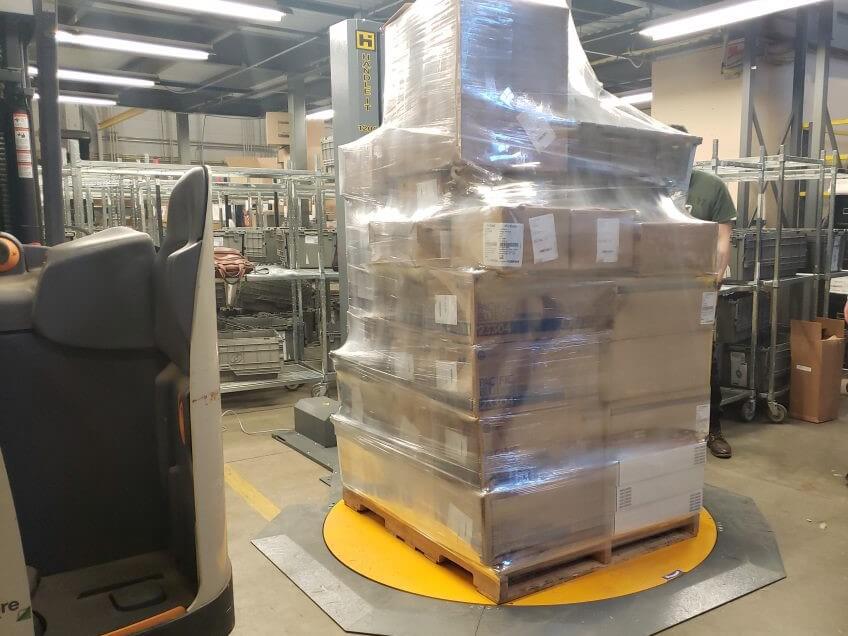
Whether your products travel by land, sea, or air, they run the very real risk of being damaged while in transit. Packaging Digest reports that anywhere from 2% to 11% of all shipments incur some form of damage by the time the products reach their final destination
Shipping products from point A to point B can be a risky journey. Vibration, impacts, and mishandling can easily damage goods along the way.
A semi or fully-automatic pallet wrapping machine helps prevent product damage—especially when wrapping pallets by hand.
Read on to learn how to properly shrink-wrap a pallet and keep your goods safe and secure.
Use common sense and avoid overloading the pallet to save on shipping. Stacking too high can create an unstable load that is hard to wrap and secure properly. Following pallet wrapping guidelines for maximum load weight and height will ensure a secure wrap.
Before wrapping, check the load stability by calculating the pallet’s capacity. Ensure the products’ total weight and height do not exceed the pallet’s load limits. Use more stretch wrap for heavier, less stable loads. The more the products shift or lean, the more you’ll need to secure them.
Once the pallet is on the shrink wrapper, you’ll need to attach the film to the pallet. The best attachment point is in the lower corner of the pallet, further away from the carriage. Automatic pallet wrappers perform this step automatically, so workers don’t have to get off the forklift.
After you’ve attached the film, head over to the pallet wrapper control panel and make the following adjustments:
Revolution speed—Set the revolution speed appropriately. Too fast may topple the load, but it should still wrap quickly enough for production needs. Find the right speed that secures the products without slowing down wrapping.
Carriage ascent and descent speeds—Assess the pallet height and weight. Then adjust the carriage ascent and descent speeds accordingly:
The goal is to optimize the speed to use just enough wrap to fully secure the load without wasting excess. Watch the coverage and adjust speed as needed.
Film force tension—Properly setting the tension is critical for a quality pallet wrap. Be careful not to over-tighten the pressure to prevent damage. This can lead to film tearing or crushed boxes on the bottom layers.
Start with moderate tension and observe the results. Adjust as needed based on the load weight. Use lighter tension for lighter loads to avoid damage. Increase tension for heavier loads to contain them securely.
*Note: Machines with the power pre-stretch feature tend to need less film force tension because it has memory. It will constrict back to the load after passing through the rollers.
Photo-eye delay setting—There is a control setting that causes the film to curl over the top of the load. Typically, for an A-load, you’ll want around 3-6″ of overwrap to help contain the uppermost boxes on the pallet.
Assess the uniformity and weight of the pallet load. Then adjust the photo-eye delay setting accordingly:
Watch the overwrap as you test your settings. Adjust the delay until you reach the proper overlap for the specific pallet.
For a standard pallet of boxes under 2,000 pounds, set the top and bottom wrap settings to about three revolutions. This should be enough to secure lighter loads. If you need to apply more wrap, try to avoid overdoing it. You’ll wind up wasting time and money and won’t see an increased benefit.
Perform an initial test wrap for the first pallet load. Yes, it might take a little longer at first. However, you’ll know exactly how fast or slow you must go when wrapping similar pallets.
Generally, it is better to start with slower speeds for both the turntable and the carriage. Gradually increase the speeds in small increments to find the optimal settings and ensure a safe and secure wrap.
Setting the tension at about halfway is a good starting point unless you have fragile boxes. In that case, start at around 20%. You’ll eventually get a sense of optimizing the cycle time and balancing the appropriate amount of wrap film.
Once the test wrap completes, pay particular attention to the bottom wraps to help secure the load to the pallet. Extra top wrap revolutions can also be helpful for unstable loads.
Finally, check the overall stability of the wrapped pallet. Does it seem stable and well-protected? If not, go back and adjust the stretch wrapper settings further. If so, cut the film and wrap it around the base of the pallet.
The Model 1100 Series semi-automatic stretch wrap machine cuts and tucks the wrap into the base of the pallet automatically. Automating this final step saves time and allows the operator to remain on their forklift.
See how quick and easy it is to securely wrap a pallet with the Handle It Model 850PS shrink-wrapping machine..
When it comes to wrapping a pallet of boxes with a pallet wrapper, there are several things that you can do that will help ensure a successful and secure wrap. Read on to learn more about how to properly shrink wrap a pallet and keep your goods safe and secure.
When initially loading the pallet with your products, let common sense be your guide. Don’t try to stack too many boxes to save a few bucks on shipping costs. You could potentially create a situation where you’re hoping the wrap job will somehow be able to overcome the laws of physics.
Before you load the pallet onto the pallet wrapping machine, assess how stable your products are by learning how to calculate pallet load capacity. A general rule of thumb is that the heavier and less stable the load, the more stretch film you should apply.
After you’ve loaded the pallet with boxes and placed it onto the pallet wrapping machine, head over to the control panel on the pallet wrapper and make the following adjustments:
Revolution speed — set this to an appropriate level. Too fast, and you can run the risk of toppling the load—however, you still want it to be fast enough to keep up with your production.
Carriage ascent and descent speeds — you should set them to optimize the film coverage throughout the load height. If you have the speed set too fast, you can leave uncovered gaps. Too slow, and you can be wasting film. Again, this depends on the pallet’s weight and stability— with more film needed with heavier and unstable pallets.
Film force tension — is another basic setting that you will want to dial in for a proper pallet wrap. Set the film force tension so that the film applied holds to the product but not so tight that you crush the load. Keep in mind that if you set it too tight, you can run the risk of film tearing, which can cause time delays or crushed boxes.
*Note that machines with power pre-stretch tend to need less film force tension because the film has memory and will constrict back to the load after being stretched through the film rollers.
Photo-eye delay setting — A setting within the controls allows you to get the film to curl over the top of the load. Typically, for an A-load, you’ll want around 3-6″ of overwrap to help contain the uppermost boxes on the pallet.
As a general rule of thumb, a standard load of boxes that weighs less than 2,000 lbs shouldn’t need more than ~3 revolutions for the top and bottom wrap settings. Certainly, there are situations where you need to apply more film but be cautious not to waste time and money with too much stretch film.
For the first pallet load, you should perform an initial test wrap. Yes, it will take a tiny bit longer, but once you get things dialed in, you’ll have a good idea of just how fast (or slow) you need to go when wrapping subsequent pallets.
In general, it is better to start with slower speeds for both the turntable and carriage and then incrementally work up to faster speed. This will help reduce the chance of film tearing on the pallet or load and give you a better idea of how much film to apply.
Typically, setting the tension at about halfway is a good starting point unless you have fragile boxes. In that case, start at around 20%. Once you’ve wrapped a few pallets, you’ll get a sense of how to optimize the cycle time and balance the appropriate amount of film.
Once the wrap is complete, pay particular attention to the bottom wraps to help secure the load to the pallet. Extra top wrap revolutions can also be helpful for unstable loads.
Learning the correct way to use your wrapping machine will help ensure a safe and secure loading experience—and a happy customer. If you have any questions about wrapping your pallets or your current pallet wrapping machine isn’t up to par, contact us today to learn more about how Handle It can help solve your toughest wrapping challenges.
The amount of stretch wrap required depends on using pre-stretched or non-pre-stretched film. The pre-stretched wrap contains built-in tension and uses less material. Non-pre-stretched requires more revolutions and wrap to create tension around the load.
The weight, size, and consistency of the load you’re wrapping also play a factor. There are different types of stretch film to consider as well.
For a typical 40×48 inch pallet stacked around 5 feet high, you would need approximately 100-150 feet of non-pre-stretched film. However, with a pre-stretched carriage, you may only require 30-40 feet for the same size load.
This is due to the pre-stretching mechanism stretching the film as it applies it. This allows it to cover more area with fewer linear feet of wrap. Pre-stretching can dramatically reduce total wrap usage for the same coverage.
You should strap pallets before stretch-wrapping them. Strapping first provides load stability and compression. Then you can apply the stretch wrap over the straps to seal and contain the pallet. Strapping before wrapping also helps optimize pallet integrity for shipping and handling.
The number of wrap revolutions depends on the box size and weight. Uniform, lighter loads need 2-3 revolutions. Heavier or irregular loads require up to 4 revolutions to stabilize the pallet. Using more than 4 revolutions wastes film with little added benefit.
Generally speaking, avoid wrapping the same section more than 2-3 times. Instead, do 2-3 low wraps to stabilize the bottom, then 2-3 higher wraps to seal the top. Four total revolutions (2 down, two high) secure most pallets well without excessive wrap use.
Adjust the photo-eye delay to ensure complete coverage when wrapping irregular-sized loads. Start with a longer delay to prevent an early cutoff at the top. Watch the wrap and refine the setting for a proper top overlay.
Use lighter tension settings initially on uneven loads to avoid wrap breaks. Progressively increase tension for better hold without crushing contents. For tall pallets, slow the carriage speed to cover the height fully. Thicker film or lighter tension prevents punctures from sharp edges.
Taking the time to dial in a stretch wrapping machine properly pays off through securely wrapped pallets and damage-free shipping. Get in touch with us below to learn how Handle It can help solve your toughest wrapping challenges.
Contact a Pallet Wrapper Expert
BACK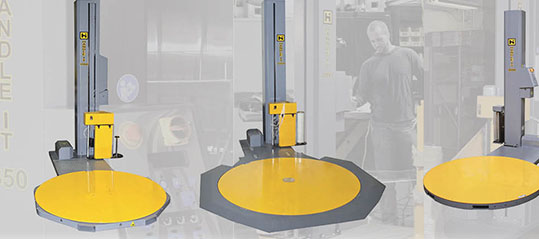
Shop our wide variety of pallet wrapping machines and stretch wrappers to improve your current packaging process.
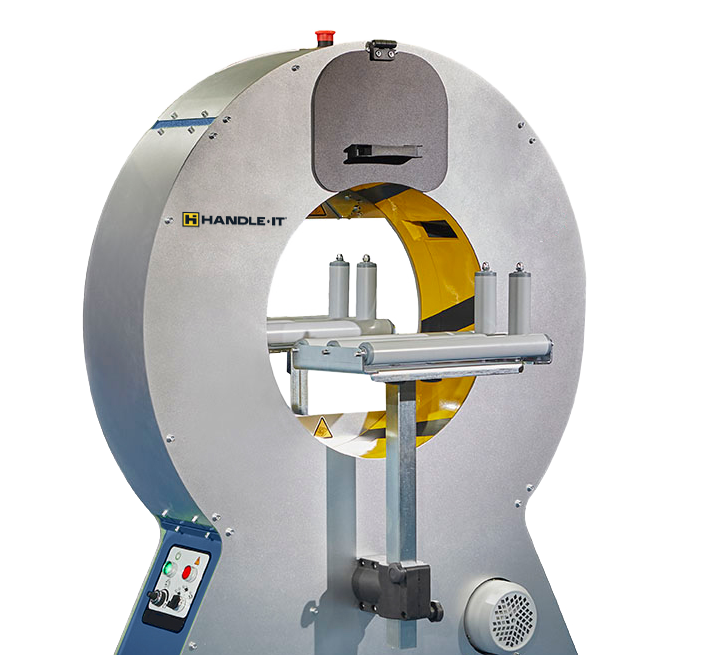
Shop our several types and sizes of orbital wrapping machines to meet your horizontal product bundling needs.
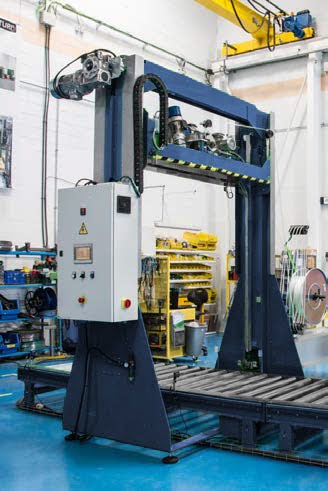
Shop our pallet strapping equipment to secure your products for safe and reliable transport.
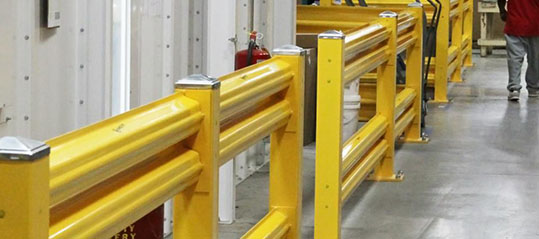
Shop our guard rail systems and components to improve the safety of the people, structures and items in your warehouse.
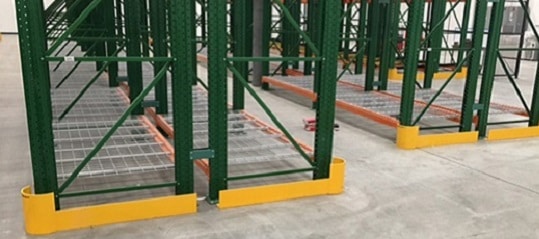
Shop rack & post protectors to decrease the damage to your pallet racks and posts due to impact from forklifts and pallets.